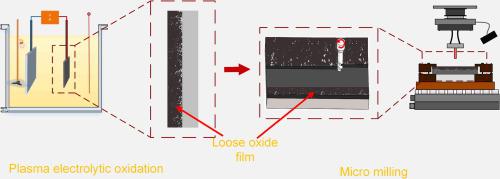Measurement ( IF 5.2 ) Pub Date : 2020-11-18 , DOI: 10.1016/j.measurement.2020.108719 Yizhong Hu , Jianbing Meng , Xiaosheng Luan , Xiaojuan Dong , Haian Zhou , Linghui Qu , Hongwei Zhang , Xiuting Wei

|
With the aim to modify the micro-milling behaviors of Ti6Al4V alloy for engineering application, a novel processing method of plasma electrolytic oxidation assisted micro-milling (PEOAM) was proposed in this paper. Ti6Al4V alloy was treated by plasma electrolytic oxidation (PEO) with an electrolyte mainly containing KH2PO4 and Ca(CH3COO)2, so that a low-strength oxide film that could be easily removed grew in-situ on the alloy surface. The oxide film was then subjected to micro-milling. The structure and composition of the oxide surface layer and sub-surface layer were characterized by scanning electron microscope and X-ray spectrometer. The cutting force of micro-milling applied to the oxide film was detected by dynamometer. Meanwhile, the milled surface roughness and top burrs were measured and analyzed by white light interferometer. The results indicated that PEO could promote the in-situ growth of 19μm-thick loose and porous titanium oxide film on the surface of Ti6Al4V alloy. Compared with non-oxidation specimens, the microhardness and elastic modulus of the oxide surface layer were decreased by 34.5% and 47.1%, respectively. With the same micro-milling parameters, the cutting forces Fx and Fy were decreased by 52.4% and 71.4% respectively in down milling, and 36.2% and 88.4% in up milling. The surface roughness Ra was decreased by 26.7%.
中文翻译:

Ti-6Al-4V合金的等离子电解氧化及其对微铣削加工性的影响
为了改变Ti6Al4V合金的显微铣削性能,以达到工程应用的目的,提出了一种新型的等离子体电解氧化辅助显微铣削(PEOAM)加工方法。使用主要包含KH 2 PO 4和Ca(CH 3 COO)2的电解质通过等离子电解氧化(PEO)处理Ti6Al4V合金,因此容易去除的低强度氧化膜在合金表面上原位生长。然后对氧化膜进行微研磨。通过扫描电子显微镜和X射线光谱仪表征了氧化物表面层和次表面层的结构和组成。通过测力计检测施加到氧化膜上的微铣削的切削力。同时,用白光干涉仪测量并分析了铣削后的表面粗糙度和毛刺。结果表明,PEO可以促进Ti6Al4V合金表面19μm厚的疏松多孔氧化钛膜的原位生长。与非氧化试样相比,氧化物表面层的显微硬度和弹性模量分别降低了34.5%和47.1%。在相同的微铣削参数下,F x和F y在下铣削中分别降低了52.4%和71.4%,在上铣削中分别降低了36.2%和88.4%。表面粗糙度R a降低了26.7%。











































 京公网安备 11010802027423号
京公网安备 11010802027423号